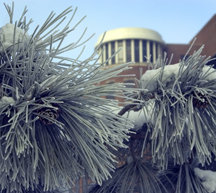Weather Preparedness
When harsh weather comes
 When harsh weather is a possibility, Purdue administrators continuously monitor forecasts to ensure public safety. The university uses several systems to alert the campus community about weather-related changes to class schedules or work hours, starting with the Purdue home page.
When harsh weather is a possibility, Purdue administrators continuously monitor forecasts to ensure public safety. The university uses several systems to alert the campus community about weather-related changes to class schedules or work hours, starting with the Purdue home page.
Purdue's severe weather policy is available online.
Alerting campus community
In addition to using the Purdue campus safety status page, the university shares information, as appropriate, through:
- Sirens
- Emergency text messages
- Campus-wide e-mail
- News media
Winter weather
 To stay warm and dry, consider
To stay warm and dry, consider
- Wearing several layers of lightweight, warm clothing
- Sporting a hat to prevent body heat loss from your head
- Using mittens that fit snugly at the wrists, which are better than gloves
- Wearing boots or shoes that provide good traction
- Taking the Purdue tunnels and enclosed walkways
- Riding CityBus
CityBus
CityBus is free to everyone with a Purdue student, faculty or staff identification card. Bus stops are located all around campus, and buses run throughout Lafayette and West Lafayette.
Changes in class or work schedules
Many variables come into play when making decisions about schedule changes. For example, in addition to temperature and wind chill, administrators consider the entire forecast for the day, snow cover, anticipated snowfall, icing, the conditions of roads and parking lots, and the ability to heat buildings and remove snow. Consideration also is given to how far people need to walk outdoors, which is greater for students than for faculty and staff, most of whom park in lots and garages near the campus.
Severe thunderstorms, tornadoes
Purdue is located in a region of the United States that is prone to dangerous weather events such as severe thunderstorms and tornadoes. On average, there are 23 tornadoes reported in Indiana annually.
The campus community can prepare by considering the following:
When a severe weather watch is issued
- Listen to local radio and TV stations for further updates.
- Be alert to changing weather conditions.
When a thunderstorm or tornado warning is issued
- Outdoor sirens placed strategically throughout campus might sound, depending upon the situation. Text messages also may be sent. (See related information) When this happens, seek shelter and tune to local radio and TV stations to determine the nature of the emergency.
- When taking shelter, go to the basement or lowest level of a building. Position yourself in an interior corridor of the area away from glass. Be prepared to kneel facing a wall and cover your head.
After the tornado touches down and then moves on
- Watch out for fallen power lines and stay out of damaged areas.
- Listen to the radio and check the Purdue home page for information and instructions.
- Do not use candles until told it is safe to do so.
Siren testing
Purdue's exterior warning sirens are tested at 11 a.m. on the first Saturday of each month, except during periods of adverse weather conditions.
Weather Web sites
The Weather Channel Web site provides current local, state and national weather conditions, weather alerts and forecasts.
The National Oceanic and Atmospheric Administration Web site also provides current local, state and national weather conditions, weather alerts and forecasts. A wind chill chart also provides helpful information on what to expect outside.

